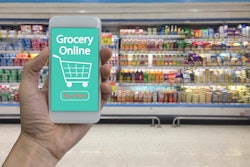Krones is an almost ubiquitous name in full line beverage can and bottle filling systems. The company builds and integrates everything from robotic can depalletizer to end-of-line palletizer to order in Germany, then delivers the turn-key systems the world over. But due to local proclivities in the U.S. and Canadian markets—in particular, a fondness for shelf-stable steel food cans commonly used for tuna fish, fruits, vegetables, and pet food—Krones is now building machines with such applications in mind here in the states. The Milwaukee-area Krones facility is now manufacturing upwards of a dozen of its Canmatic machines per year for North American brand owners. The existing facility is multi-purpose, but its training and showroom functions will soon migrate to an adjacent new facility under construction. When that move occurs, the existing facility will have 300,000 sq ft of dedicated manufacturing space, and capacity to push past the dozen machines/year pace.
Krones’ Canmatic is designed for cost-efficient pre-cut labeling. While the classic steel can is a popular application, the machine is equally adept at affixing pre-cut paper or film wrap-around labels to cans, bottles, or jars of widely differing sizes and shapes. The principle the machine works on is simple and effective—labels are attached directly to the containers without the need for gluing pallets. Canmatic uses minimal glue to accomplish this because the label is held in place by just two narrow lines of dispensed hotmelt glue.
Dual pump advantage
One Krones Canmatic customer was particularly interested in an efficient and accurate glue spray system, not a roller system, for attaching pre-cut labels. This application involved a low-profile steel can format that is commonly associated with tuna fish or pet food. In a typical configuration for this application, a can enters a carousel in the labeler, and passes by an initial hot melt glue applicator head. There, a minute spiral spray of adhesive is applied directly to the can. Carrying the spiral spot of adhesive, the can continues to revolve around its own axis on the carousel in such a way that it is correctly oriented to pick up a label from a magazine of pre-cut labels as it passes by. As it continues rotating on the carousel, the can naturally wraps itself in the pre-cut label, extracting it from the magazine.
Shortly before the rotation pulls the label completely out of the magazine, a second hot melt glue applicator applies a strip of adhesive to the internal trailing edge of the label. The second applicator head also serves to affix the trailing portion of the label to the can overlapping the front label edge, closing the label over itself.
Given its customers’ interest in glue savings, Krones turned to Robatech and its LabelStar M hot melt glue applicator. The system uses two pumps on the same tank unit and accurately tailors the pressure to the needs of both pick-up head and seal head.
“You can ideally set each independent pump to deliver the correct pressure to each head, so you’ll always find the sweet spot on each adhesive applicator head,” says Claudius Wolf, Krones.
Ultimately, the dual pump system’s extra accuracy and carefully metered control of the adhesive quantity for the needs of each individual head reduces glue consumption and limits downtime for maintenance and cleaning.
Sufficient speed
Speed was another requirement for this particular line. This Canmatic had to be able to deliver up to 1,000 cans/min in ideal settings, with a typical cruising speed of 750 to 900 cans/min. This would be demanding of most hot melt glue labeling applications given greater need for precision and reaction time at such speeds. But the low-profile size of the brightstock can further limits the available surface area, only complicating things.
While this application required a low-profile can, the machine is capable of handling a variety of different label heights because the SX 8/EL/F/NV/SP spiral application head contains five jetting elements for label pick-up. Only as many of the jetting elements as necessary will be activated for shorter applications, but if a label’s height is near the 140-mm maximum, all five jetting elements can be activated.
“On that very tiny can, we only have space to position one single pick-up spiral, and that pick-up has to generate sufficient tackiness and pull-force to extract the label from the magazine without slipping, dispositioning itself, or flagging,” Wolf says. “The Robatech system solves that problem by using two pick-up dots in sequence—not on top of each other on the vertical height of the can since there’s no space there, but in sequence around the circumference of the can. At these speeds, this application is technically very difficult, but the Robatech system achieves it.”
































